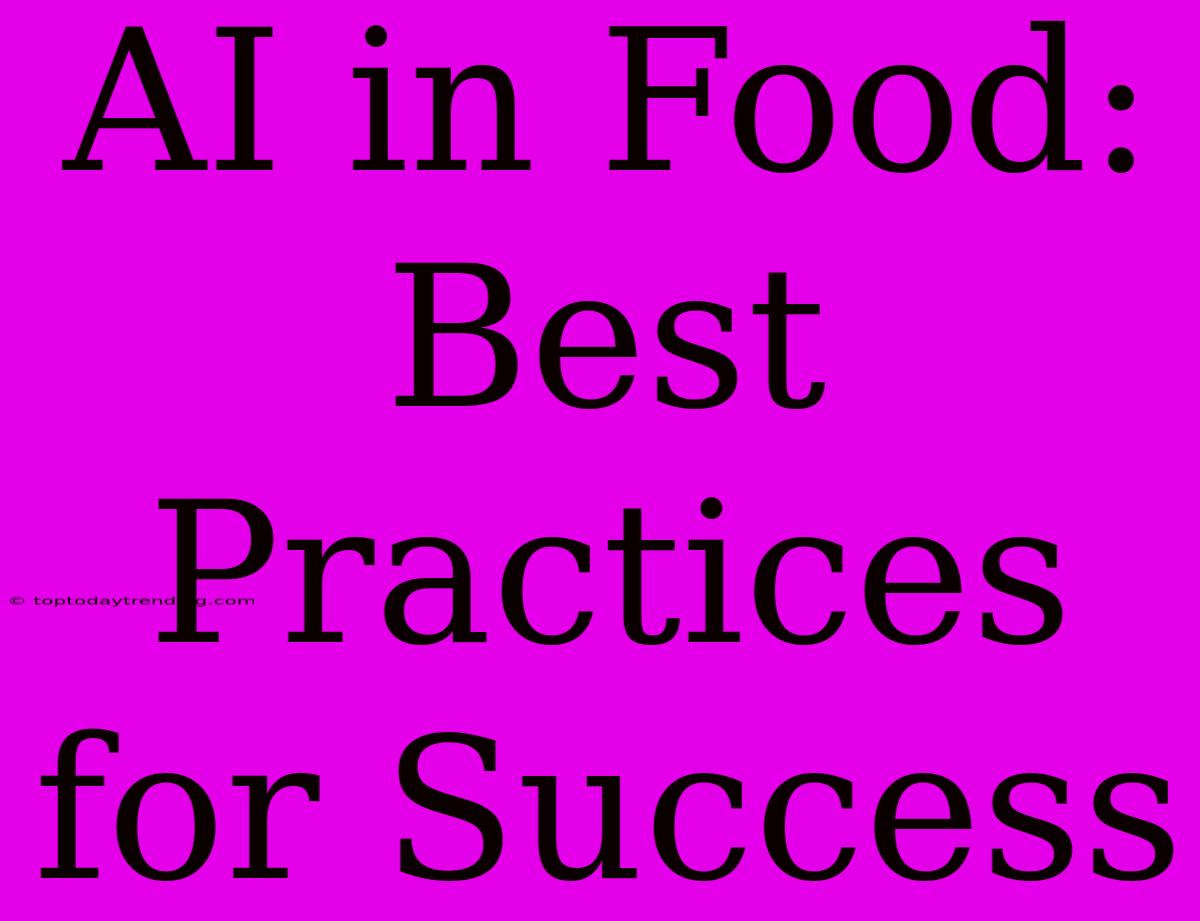AI in Food: Best Practices for Success
The food industry is undergoing a rapid transformation, driven by advancements in artificial intelligence (AI). From optimizing farm yields to personalizing consumer experiences, AI is revolutionizing every aspect of the food supply chain. While the potential is immense, achieving success with AI in food requires a strategic approach and adherence to best practices.
1. Defining Clear Goals and Objectives:
Before embarking on any AI project, it's crucial to define specific, measurable, achievable, relevant, and time-bound (SMART) goals. What specific problem are you trying to solve with AI? Are you looking to increase efficiency, improve product quality, or enhance customer satisfaction? Clearly defined goals provide direction, enable effective measurement, and ensure that your AI initiatives are aligned with your overall business objectives.
2. Data is King:
AI algorithms thrive on data. The success of your AI applications hinges on having access to high-quality, relevant, and diverse data sets. This includes operational data from farms, processing facilities, distribution networks, and consumer interactions. Ensure your data is clean, organized, and accessible for AI analysis. Invest in data infrastructure and develop robust data governance policies to ensure data quality and security.
3. Choosing the Right AI Tools and Technologies:
The vast landscape of AI tools and technologies can be daunting. Understanding the specific challenges you face and the desired outcomes will help you choose the most appropriate tools. Consider factors like:
- Machine learning (ML): For predictive analytics, forecasting, and optimization.
- Computer vision: For quality control, inventory management, and food safety.
- Natural Language Processing (NLP): For understanding consumer preferences, sentiment analysis, and chatbot development.
- Robotics: For automation tasks in production and logistics.
4. Building a Strong Team:
Implementing AI requires a diverse team with expertise in data science, machine learning, engineering, domain knowledge, and business strategy. Collaborating with experts from academia, research institutions, and AI technology providers can provide valuable insights and support.
5. Prioritizing Ethical Considerations:
AI applications in food need to address ethical concerns related to data privacy, transparency, fairness, and potential bias. Implement safeguards to ensure responsible data handling, transparency in decision-making processes, and fairness in outcomes.
6. Adopting an Iterative Approach:
AI is an iterative process. Start with small, focused pilot projects to test and validate your AI models. Continuously learn from data, refine your models, and adapt your AI solutions to evolving needs.
7. Ensuring Scalability and Integration:
Your AI solutions need to be scalable and seamlessly integrate with your existing systems and processes. Design AI infrastructure with future expansion in mind and ensure compatibility with your existing technology stack.
8. Staying Informed:
The AI landscape is constantly evolving. Stay informed about emerging technologies, best practices, and regulatory changes. Attend industry events, engage with research communities, and cultivate a culture of continuous learning.
9. Focusing on Customer Value:
Ultimately, AI should create value for your customers. Whether it's improving product quality, personalizing recommendations, or enhancing convenience, ensure your AI solutions are designed to meet real customer needs.
10. Building Trust and Transparency:
Communicate clearly with your customers about how you are using AI. Build trust by being transparent about data collection, algorithm decision-making, and the benefits your AI solutions deliver.
Success Stories:
- Precision Agriculture: AI is helping farmers optimize crop yields by using drones, sensors, and predictive analytics to analyze soil health, weather patterns, and pest infestations.
- Food Safety and Quality Control: AI-powered computer vision systems are used to identify defects, contaminants, and adulteration in food products, ensuring higher quality and safety standards.
- Personalized Nutrition: AI algorithms can analyze dietary data and health information to provide personalized nutrition recommendations, meal plans, and health monitoring tools.
The Future of AI in Food:
The future holds exciting possibilities for AI in food. We can expect advancements in areas such as:
- Sustainable Food Production: AI can help reduce food waste, optimize resource use, and develop alternative protein sources.
- Personalized Food Experiences: AI will enable hyper-personalized food recommendations, meal plans, and customized food products.
- Food Traceability and Supply Chain Management: AI will enhance food traceability, enabling better tracking of food origins and reducing the risk of foodborne illnesses.
By embracing these best practices, the food industry can unlock the full potential of AI to create a more sustainable, efficient, and consumer-centric food system.

